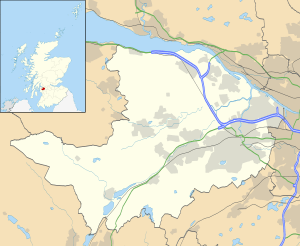Gryffe Castle facts for kids
Gryffe Castle is a historic place in Renfrewshire, Scotland. It's located about half a mile north of Bridge of Weir. While the current building is a large house from the 1800s, there has been a "Gryffe Castle" in this area since at least 1474.
Quick facts for kids Gryffe Castle |
|
|---|---|
| Coordinates | 55°51′46″N 4°34′57″W / 55.8628°N 4.5824°W |
| Site history | |
| Built | by 15th century |
A Look at Gryffe Castle's Past
Gryffe Castle is a beautiful building near Bridge of Weir. It's one of the most elegant homes in the area. The current large house was built around 1854. But there have been buildings called Gryffe Castle on this spot for a very long time.
Early Mentions of Gryffe Castle
The first time Gryffe Castle is mentioned is in 1474. King James II confirmed a special document, called a charter. This charter gave Gryffe Castle from John Knox to his son, Uchtred Knox. The Knox family owned a big part of the land for many years.
Changing Owners Through the Centuries
Around 1619, a part of the Gryffe Castle land went to Hugh of Montford. His family lived there until the late 1600s. But the Knox family kept the main part of the estate. In 1665, they sold it to Lord Cochrane. He later became the first Earl of Dundonald. He also owned land in a place now called Johnstone.
The Modern Mansion is Built
The current large house was built in the mid-1800s. It was built by Robert Freeland of Broomward. His grandfather, John, had started a cotton-spinning business. This business was at the Gryffe Mill in Bridge of Weir around 1779. When Robert moved to Gryffe Castle, his old home became part of the Gryffe Mill. Many people from the village worked at the mill.
Famous Families at Gryffe Castle
Over the years, Gryffe Castle became home to many important families. These families were well-known in Renfrewshire.
The Barbour and Campbell Families
The Barbours were one family who lived there. They owned land near Kilbarchan. William Alexander Campbell also lived at Gryffe Castle. His cousin, Sir Henry Campbell Bannerman, was the Prime Minister of the United Kingdom. This was in the early 1900s.
Later Residents and Changes
The Dowager Lady Bine Renshaw moved into the castle in May 1924. Major Harold Glen Coats of Paisley bought the castle in 1931. He made many changes to the building. He also built cottages on the land for his workers.
Sadly, Major Glen Coats passed away just two years later. His wife and family stayed there until 1949. During World War II, the Army used the mansion as their headquarters. The family lived in one of the cottages during that time.
Gryffe Castle Becomes a Children's Home
After the war, the mansion was sold to the Corporation of Glasgow. It was then used as a home for children. Mrs. Glen Coats moved away. When she passed away in 1969, it marked the end of a long line of families. These families had owned Gryffe Castle for almost 500 years.
Ancient Fortifications Nearby
There's a raised area nearby that suggests something interesting. It's thought that a Norman castle might have stood there as early as the 12th century. This would have been similar to Ranfurly Castle. These old castles were called "mote-and-bailey" castles. They were wooden buildings on mounds, surrounded by fences made of stakes.
Structure of Gryffe Castle
It's possible that parts of the very old castle are now inside the modern mansion. However, there isn't clear proof of an ancient building. Still, the location is very good for a castle. This suggests it was likely used for one long ago.


